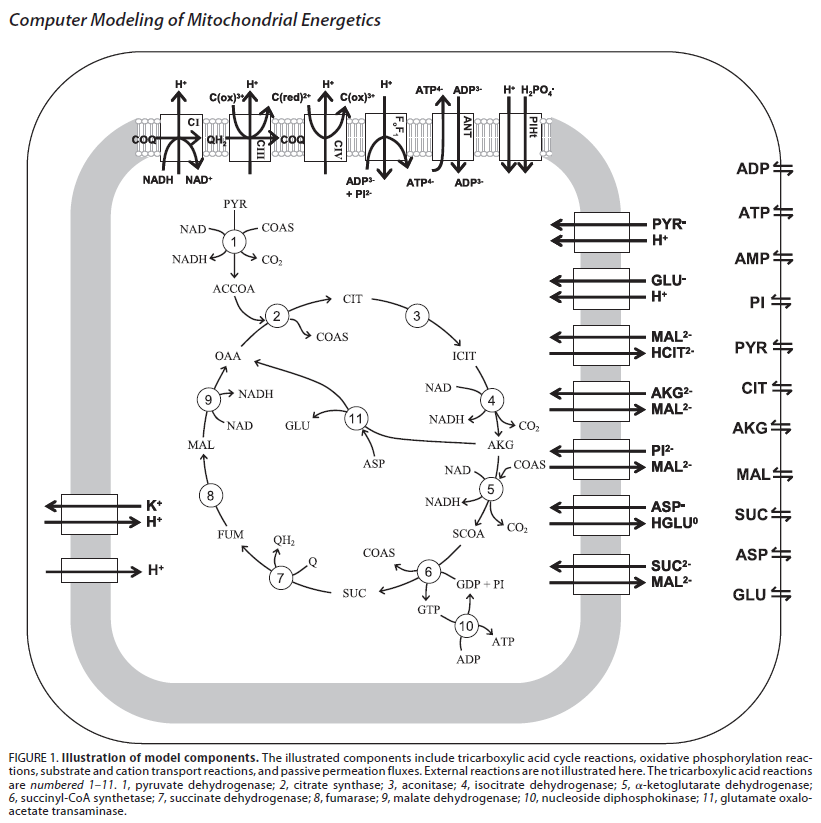Computer Modeling of Mitochondrial Tricarboxylic Acid Cycle, Oxidative Phosphorylation, Metabolite Transport, and Electrophysiology.
Description
ABSTRACT: A computational model of mitochondrial metabolism and electrophysiology is introduced and applied to analysis of data from isolated cardiac mitochondria and data on phosphate metabolites in striated muscle in vivo. This model is constructed based on detailed kinetics and thermodynamically balanced reaction mechanisms and a strict accounting of rapidly equilibrating biochemical species. Since building such a model requires introducing a large number of adjustable kinetic parameters, a correspondingly large amount of independent data from isolated mitochondria respiring on different substrates and subject to a variety of protocols is used to parameterize the model and ensure that it is challenged by a wide range of data corresponding to diverse conditions. The developed model is further validated by both in vitro data on isolated cardiac mitochondria and in vivo experimental measurements on human skeletal muscle. The validated model is used to predict the roles of NAD and ADP in regulating the tricarboxylic acid cycle dehydrogenase fluxes, demonstrating that NAD is the more important regulator. Further model predictions reveal that a decrease of cytosolic pH value results in decreases in mitochondrial membrane potential and a corresponding drop in the ability of the mitochondria to synthesize ATP at the hydrolysis potential required for cellular function. The original paper reference is cited below: Computer Modeling of Mitochondrial Tricarboxylic Acid Cycle, Oxidative Phosphorylation, Metabolite Transport, and Electrophysiology, Fan Wu, Feng Yang, Kalyan C. Vinnakota, Daniel A. Beard, 2007, Journal of Biological Chemistry, volume 282, PubMed ID: 17591785

Above figure taken directly from Wu et al. 2007 paper.
Equations
The equations for this model may be viewed by running the JSim model applet and clicking on the Source tab at the bottom left of JSim's Run Time graphical user interface. The equations are written in JSim's Mathematical Modeling Language (MML). See the Introduction to MML and the MML Reference Manual. Additional documentation for MML can be found by using the search option at the Physiome home page.
- Download JSim model MML code (text):
- Download translated SBML version of model (if available):
- Wu et al. 2007 paper
- Original Matlab model source (VPR website).
- Original CellML source (CellML website).
We welcome comments and feedback for this model. Please use the button below to send comments:
Fan Wu, Feng Yang, Kalyan C. Vinnakota, Daniel A. Beard, Computer Modeling of Mitochondrial Tricarboxylic Acid Cycle, Oxidative Phosphorylation, Metabolite Transport, and Electrophysiology, 2007, J of Biological Chem, vol 282. PMID: 17591785 LaNoue, K., Nicklas, W. J., and Williamson, J. R. (1970) J. Biol. Chem. 245, 102–111 Bose, S., French, S., Evans, F. J., Joubert, F., and Balaban, R. S. (2003) J. Biol. Chem. 278, 39155–39165 Orig CellML model: www.models.cellml.org/exposure/357bde3407ba7c30baafce4903674d97
Please cite https://www.imagwiki.nibib.nih.gov/physiome in any publication for which this software is used and send one reprint to the address given below:
The National Simulation Resource, Director J. B. Bassingthwaighte, Department of Bioengineering, University of Washington, Seattle WA 98195-5061.
Model development and archiving support at https://www.imagwiki.nibib.nih.gov/physiome provided by the following grants: NIH U01HL122199 Analyzing the Cardiac Power Grid, 09/15/2015 - 05/31/2020, NIH/NIBIB BE08407 Software Integration, JSim and SBW 6/1/09-5/31/13; NIH/NHLBI T15 HL88516-01 Modeling for Heart, Lung and Blood: From Cell to Organ, 4/1/07-3/31/11; NSF BES-0506477 Adaptive Multi-Scale Model Simulation, 8/15/05-7/31/08; NIH/NHLBI R01 HL073598 Core 3: 3D Imaging and Computer Modeling of the Respiratory Tract, 9/1/04-8/31/09; as well as prior support from NIH/NCRR P41 RR01243 Simulation Resource in Circulatory Mass Transport and Exchange, 12/1/1980-11/30/01 and NIH/NIBIB R01 EB001973 JSim: A Simulation Analysis Platform, 3/1/02-2/28/07.

